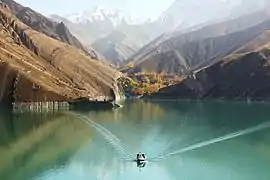Silveh Dam
The Silveh Dam is an earth-fill embankment dam on the Lavin River just downstream of the village of Silveh in Piranshahr County, West Azerbaijan Province, Iran. The primary purpose of the dam is interbasin transfer for irrigation. Since completion, a tunnel and canals shift water from the reservoir north to the Chaparabad area. The project essentially transfers water from the Little Zab River basin to the Lake Urmia basin in an effort to help replenish the lake and irrigate about 9,400 ha (23,000 acres) of farmland.[1] Construction on the dam began in 2004 and it was expected to be complete by the end of 2015.[2][3] The dam was effectively completed as of 2018.[4] The village of Silveh will be flooded when the reservoir is impounded.[5]
| Silveh Dam | |
|---|---|
 Location of Silveh Dam in Iran | |
| Country | Iran |
| Location | Lahijan-e Gharbi Rural District, Lajan District, Piranshahr County, West Azerbaijan Province, Iran |
| Coordinates | 36°47′0.32″N 45°6′47.30″E |
| Purpose | Inter basin transfer, Irrigation |
| Status | Operational |
| Construction began | 2004 |
| Opening date | 2015 |
| Owner(s) | West Azerbaijan Regional Water Authority |
| Dam and spillways | |
| Type of dam | Embankment, earth-fill |
| Impounds | Lavin River |
| Height (foundation) | 102 m (335 ft) |
| Height (thalweg) | 93 m (305 ft) |
| Length | 750 m (2,460 ft) |
| Spillway type | Uncontrolled, service |
| Spillway capacity | 1,040 m3/s (37,000 cu ft/s) |
| Reservoir | |
| Creates | Silveh Reservoir |
| Total capacity | 163,000,000 m3 (132,000 acre⋅ft) |
The dam is 102 m (335 ft) above its foundation with a length of 750 m (2,460 ft). It has an uncontrolled spillway with a maximum discharge capacity of 1,040 m3/s (37,000 cu ft/s). The reservoir created by the dam will store 163,000,000 m3 (132,000 acre⋅ft) of water. Near the northeastern edge of the reservoir water will be able to enter a 841 m (2,759 ft) long tunnel which will discharge it into the opposing valley, within the Lake Urmia basin. About 121,700,000 m3 (98,700 acre⋅ft) of water will be transferred through the tunnel annually while an estimated 10,800,000 m3 (8,800 acre⋅ft) will be sent downstream to Piranshahr during the same period.[6]
See also
- Sardasht Dam – under construction downstream
- List of dams and reservoirs in Iran
References
- Edris Merufinia, Azad Aram, Fatemeh Esmaeili (2014). "Saving the Lake Urmia: from Slogan to Reality (Challenges and Solutions)" (PDF). Bulletin of Environment, Pharmacology and Life Sciences. 3 (3). ISSN 2277-1808. Retrieved 20 January 2015.CS1 maint: multiple names: authors list (link)
- "Completed by the end of the 94 dams Silveh Piranshahr" (in Persian). Kurd Press. 23 August 2014. Archived from the original on 20 January 2015. Retrieved 20 January 2015.
- "Evaluating Liquefaction Potential in an Embankment Dam Foundation Using Shear Wave Velocity Measurements". CSCE 2007 Annual General Meeting & Conference. June 2007. Retrieved 20 January 2015.
- Jafarzadeh, Fardin (July 2018). "Sealing Performance of Silveh Embankment Dam Cutoff Wall Based on Instrumentation Measurements". Researchgate.
- "Villages under the dam Silveh determine Piranshahr" (in Persian). MEHR News Agency. 14 August 2014. Retrieved 20 January 2015.
- "Silveh Dam and Irrigation and Drainage" (in Persian). Omran Iran - Deputy Governor of West Azerbaijan. Archived from the original on 20 January 2015. Retrieved 20 January 2015.
